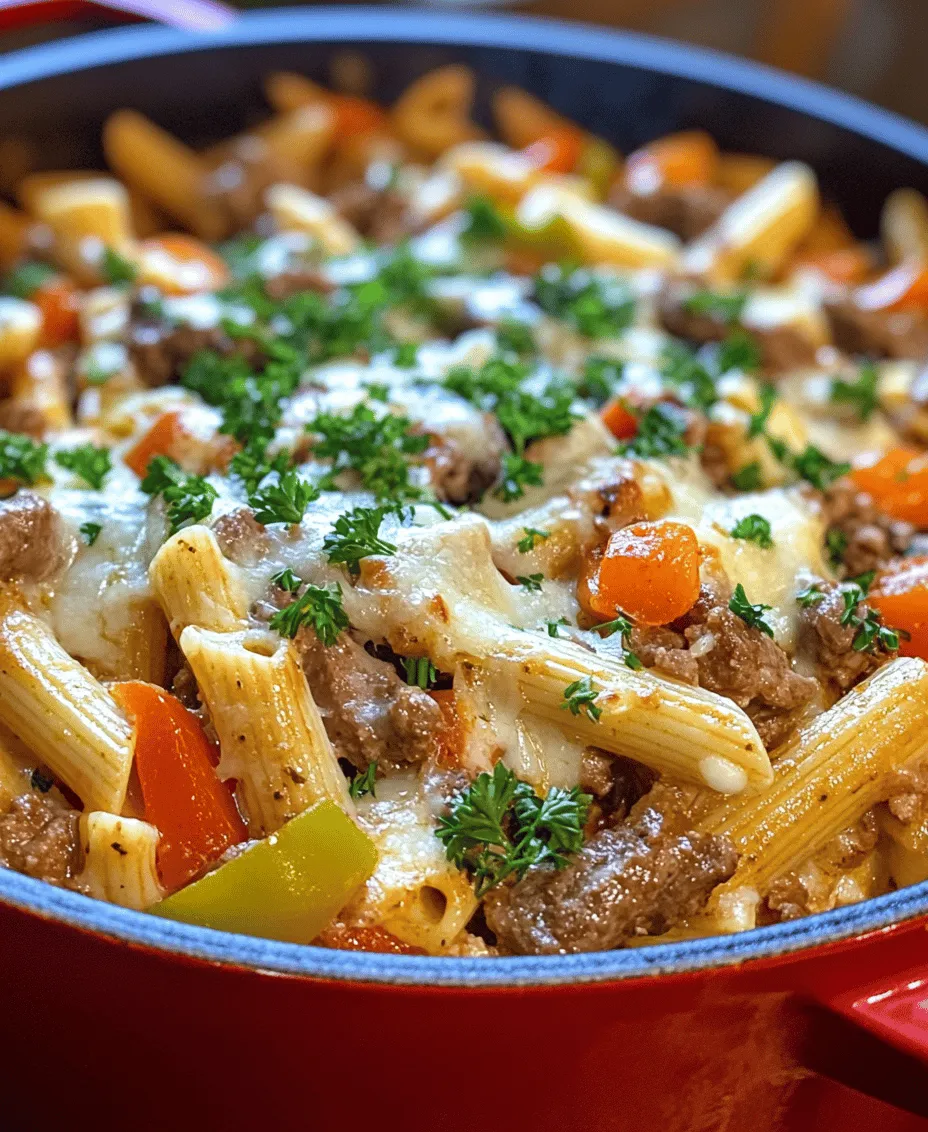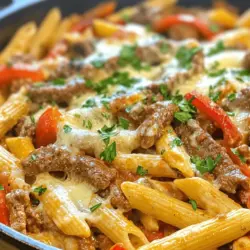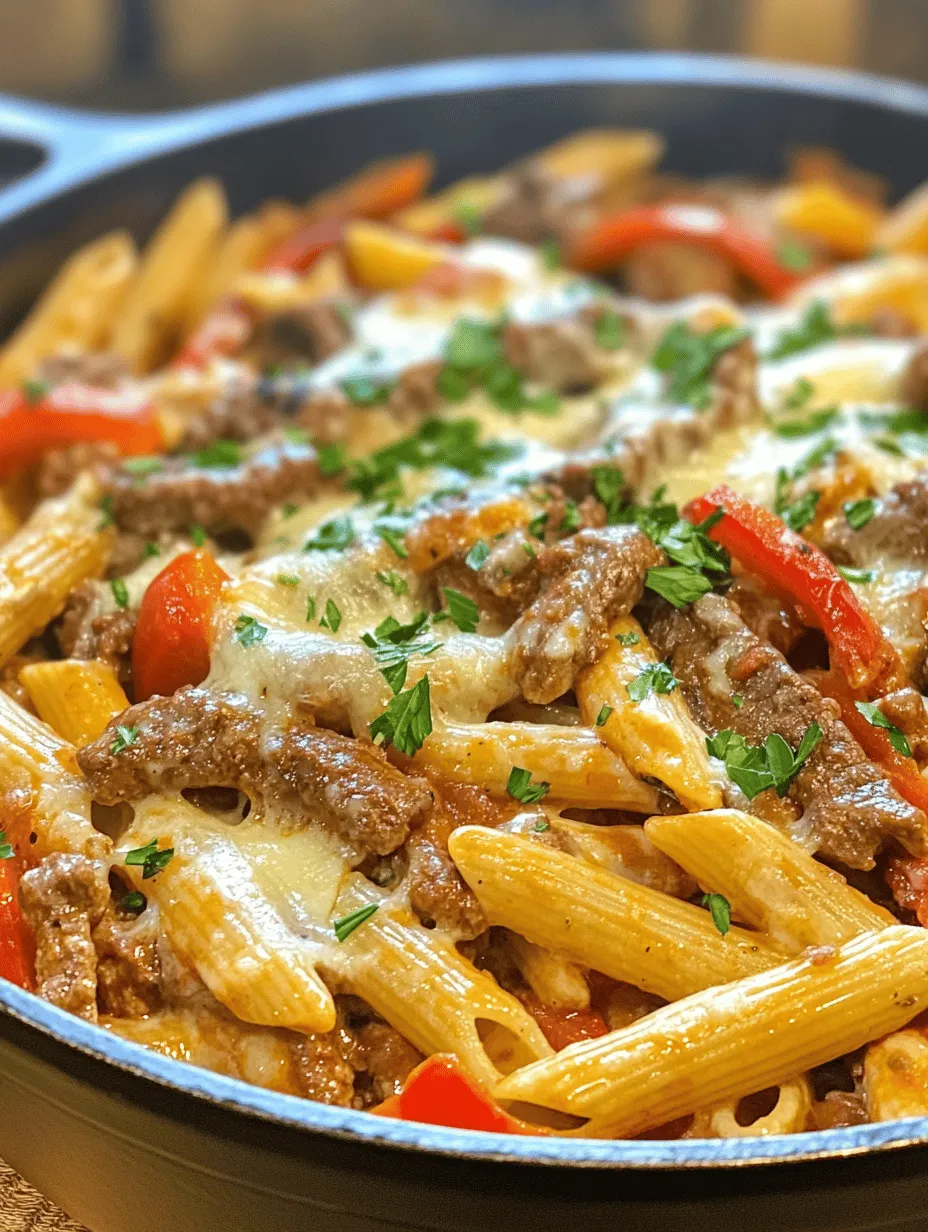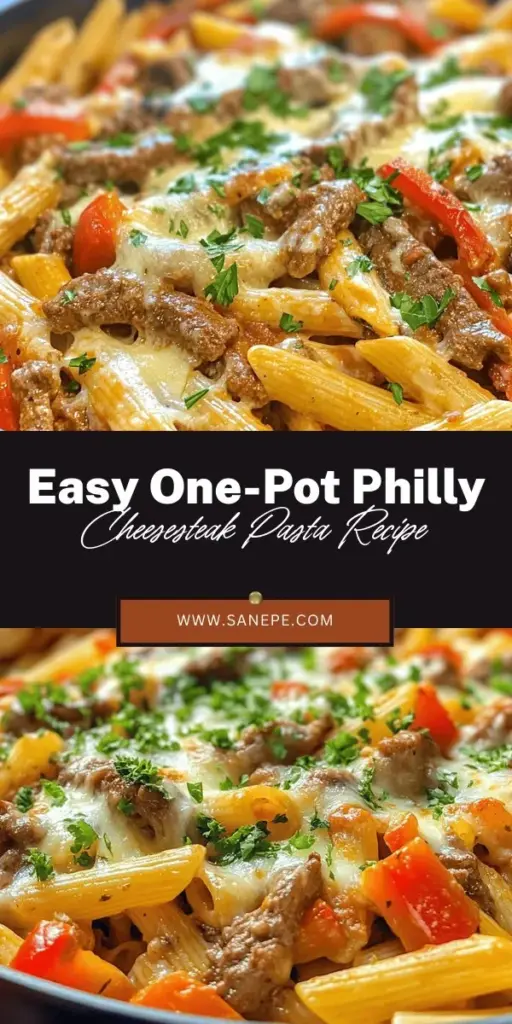Introduction
If you’re a fan of rich, savory flavors and hearty meals, the One-Pot Philly Cheesesteak Pasta is a dish you cannot miss. This fusion creation brings the iconic flavors of the classic Philly cheesesteak sandwich into a comforting pasta dish that is perfect for any night of the week. Picture this: tender pieces of steak, sautéed onions, and sweet bell peppers tossed in a creamy, cheesy sauce, all enveloped around perfectly cooked pasta. This dish not only satisfies hunger but also evokes the nostalgia of a beloved sandwich.
The appeal of One-Pot meals lies in their simplicity and convenience. In today’s fast-paced world, the idea of creating a flavorful, satisfying dinner without the hassle of extensive cleanup is incredibly attractive. One-Pot meals allow you to combine everything in a single pot, minimizing dirty dishes and maximizing flavor. With the One-Pot Philly Cheesesteak Pasta, you get all the deliciousness of a cheesesteak without the need for a sub roll, making it a perfect solution for busy weeknight dinners.
The Essence of One-Pot Meals
One-pot cooking is a culinary approach where all ingredients are combined and cooked together in a single pot, pan, or skillet. This method not only simplifies the cooking process but also ensures that all the flavors meld beautifully, creating a dish that is greater than the sum of its parts. The ease of preparation is one of the most enticing aspects of one-pot meals; you can often have dinner on the table in 30 minutes or less.
For busy families and individuals juggling work, school, and various commitments, one-pot meals present an ideal solution. They allow you to spend less time in the kitchen and more time enjoying your meal with loved ones. Additionally, the minimal cleanup required means that you can relax after dinner without the burden of a pile of dishes waiting for you. With the One-Pot Philly Cheesesteak Pasta, the combination of convenience and flavor makes it a go-to recipe that will quickly become a favorite.
Understanding the Ingredients
To create a delectable One-Pot Philly Cheesesteak Pasta, it’s essential to understand the key ingredients that will contribute to the dish’s overall flavor and texture.
Key Ingredients Overview
1. Pasta: The type of pasta you choose plays a significant role in the dish. Penne and rigatoni are excellent choices, as their tubular shapes hold onto the creamy sauce, ensuring that every bite is bursting with flavor. These pasta shapes also complement the heartiness of the steak and veggies.
2. Steak: When it comes to the meat, the choice of steak cut can make a considerable difference in both flavor and tenderness. Ribeye steak is known for its marbling and rich flavor, making it a popular choice for cheesesteaks. However, sirloin steak is also a fantastic option if you prefer something leaner. Both cuts can provide the juicy, beefy essence that is crucial to this dish.
3. Vegetables: Onions and bell peppers are traditional elements in a Philly cheesesteak, and they play a vital role in enhancing the overall flavor profile. Sautéing these vegetables until they are caramelized brings out their natural sweetness, adding depth to the dish.
4. Liquid Ingredients: The choice of liquids is critical in creating a rich and creamy sauce. Beef broth serves as a flavorful base, while heavy cream adds creaminess and body to the dish. A splash of Worcestershire sauce not only enhances the beef flavor but also adds a touch of umami that ties everything together.
5. Cheese: No cheesesteak would be complete without cheese, and for this pasta dish, provolone cheese is a perfect choice. Its mild, creamy flavor melts beautifully, creating a luscious sauce. Alternatively, you can use a blend of cheeses, such as mozzarella and cheddar, to add extra flavor and creaminess.
Step-by-Step Cooking Instructions
Now that we have a good understanding of the ingredients, let’s dive into the cooking process. The following steps will guide you through the preparation of the One-Pot Philly Cheesesteak Pasta, ensuring that you achieve the best possible flavor and texture.
Sautéing the Vegetables
1. Heat the Pot: Start by heating a large pot or deep skillet over medium heat. Add a drizzle of olive oil to the pot; this will help to prevent the vegetables from sticking and add a rich flavor.
2. Add Onions and Peppers: Once the oil is shimmering, add sliced onions and bell peppers to the pot. Sauté them for about 5-7 minutes, stirring occasionally, until they become soft and slightly caramelized. The goal here is to bring out the natural sweetness of the vegetables, which will add depth to the dish.
3. Seasoning: As the vegetables cook, sprinkle in some salt and pepper to taste. This step is crucial, as seasoning the vegetables enhances their flavor and ensures that they complement the beef well.
Cooking the Steak
4. Add the Steak: After the vegetables are nicely sautéed, it’s time to add the steak. Cut the steak into thin strips, as this will help it cook quickly and evenly. Add the steak to the pot and increase the heat to medium-high.
5. Sear the Meat: Allow the steak to sear for about 3-4 minutes without stirring too much. This will create a beautiful brown crust on the meat, locking in juices and flavor. Once seared, stir the steak and continue to cook until it is browned but still tender—about another 2-3 minutes.
6. Deglazing the Pot: To enhance the flavor of your dish, consider deglazing the pot. You can do this by adding a splash of beef broth and scraping up any browned bits stuck to the bottom. This step adds an extra layer of flavor to the sauce.
As you progress through these steps, you will begin to experience the wonderful aroma of the sautéed vegetables and seared steak filling your kitchen. The combination of these ingredients sets the stage for a satisfying and hearty meal that will delight everyone at the table.
In the next part of this article, we will continue with the cooking instructions, including how to incorporate the pasta and create the creamy sauce that will tie the dish together beautifully. Stay tuned for more delicious details and tips to help you master the One-Pot Philly Cheesesteak Pasta!

Combining Ingredients: Achieving the Perfect Balance of Flavors
The magic of the One-Pot Philly Cheesesteak Pasta lies in how each ingredient contributes to a harmonious blend of flavors. Start by adding the sautéed onions and bell peppers to the pot filled with cooked pasta and seared steak. These veggies not only provide a delightful crunch but also infuse the dish with sweetness and a hint of smokiness. Stirring gently ensures that every bite contains a mixture of those key flavors.
Next, pour in the beef broth and a splash of Worcestershire sauce. These components are essential for building a flavorful base. The broth adds depth while the Worcestershire sauce brings that umami kick reminiscent of a classic cheesesteak. As you stir, taste the mixture; you might find that a pinch of salt or a dash of black pepper is necessary to enhance the overall flavor profile.
Finally, the pièce de résistance: the cheese. As you prepare to add it, ensure that the pasta and steak mixture is still warm, so the cheese melts beautifully into the sauce. The goal is to create a rich, creamy texture that coats the pasta, enlivening the dish with that signature cheesesteak flair.
Simmering: Absorbing Flavors and Liquids
After combining all the ingredients, it’s time for the simmering phase. Reduce the heat to low and cover the pot, allowing the pasta to simmer gently. This step is crucial as it provides time for the pasta to absorb the flavors of the broth and the seasonings.
Simmering creates a luscious sauce that clings to each piece of pasta, while the heat helps meld the flavors together. The starches released from the pasta during this process also work to thicken the sauce, creating a delightful creaminess without the need for heavy creams or additional thickeners.
Keep an eye on it—simmering should last about 10-15 minutes. Stir occasionally to prevent sticking and to ensure everything cooks evenly. The result should be tender pasta enveloped in a rich, cheesy sauce that mirrors the taste of a traditional Philly cheesesteak.
Adding Cheese: Creating a Creamy Texture and Enhancing Taste
Once the simmering is complete and the pasta has absorbed much of the broth, it’s time to add cheese. For the best results, opt for provolone or American cheese, which melts beautifully and provides a creamy texture.
Tear the cheese into small pieces and sprinkle it over the pasta mixture. Stir vigorously until the cheese is fully melted and integrated. This step transforms your dish from a simple pasta meal into a luxurious, comforting bowl of goodness.
If you want to enhance the cheesiness further, consider layering additional cheese on top and broiling it for a few minutes until bubbly and golden. This step is optional but adds a lovely texture contrast to the dish.
Nutritional Breakdown
Understanding the nutritional value of your meals not only helps in planning a balanced diet but also allows you to enjoy your favorites guilt-free.
Protein Content from Steak and Cheese
This One-Pot Philly Cheesesteak Pasta is packed with protein thanks to the steak and cheese. A typical serving contains around 25-30 grams of protein, making it a filling option for those looking to boost their protein intake. Steak provides essential amino acids necessary for muscle repair and growth, while cheese contributes a creamy texture and additional protein.
Carbohydrate Content from Pasta
The pasta serves as the primary carbohydrate source in this dish. Depending on the type of pasta you use, the carbohydrate content will vary. A standard serving of cooked pasta contains approximately 40-45 grams of carbohydrates. To balance the meal, consider serving it with a side salad rich in fiber, which can help regulate blood sugar levels and keep you feeling full longer.
Caloric Considerations for Portion Control
When it comes to calories, a serving of One-Pot Philly Cheesesteak Pasta can range from 500 to 700 calories, depending on portion size and specific ingredients used. For those mindful of caloric intake, consider portion control strategies such as using smaller plates or measuring out servings. Additionally, using whole-grain or lower-calorie pasta can help reduce the overall caloric load without sacrificing taste.
Serving Suggestions
To elevate your One-Pot Philly Cheesesteak Pasta experience, consider serving it with complementary side dishes. A crusty piece of bread is perfect for soaking up the savory sauce, while a fresh side salad can add a refreshing crunch. A simple arugula or mixed greens salad dressed with balsamic vinaigrette pairs wonderfully, balancing the richness of the pasta.
For those looking to customize their dish, consider adding vegetables such as mushrooms, spinach, or zucchini for extra nutrition and flavor. If you enjoy a bit of heat, sprinkle some red pepper flakes or add sliced jalapeños to the mix.
When it comes to presentation, use a large, shallow bowl to serve the pasta, garnishing it with freshly chopped parsley or additional cheese. This not only makes the dish visually appealing but also enhances the aroma, inviting everyone to dig in.
Storage and Reheating Tips
If you find yourself with leftovers (which is likely, given how hearty this dish is), proper storage is essential to maintain freshness. Allow the pasta to cool to room temperature before transferring it to an airtight container. Store it in the refrigerator for up to 3-4 days.
When it comes to reheating, the stovetop is your best bet to maintain flavor and texture. Place the leftovers in a skillet over low heat, adding a splash of beef broth or water to prevent sticking and to help rehydrate the pasta. Stir occasionally until heated through.
If you wish to freeze the dish, ensure it’s in a freezer-safe container. It can be frozen for up to 2 months. When you’re ready to enjoy it again, thaw it overnight in the refrigerator before reheating.
Conclusion
One-Pot Philly Cheesesteak Pasta is more than just a meal; it’s a celebration of flavors, ease, and comfort. The combination of tender steak, vibrant vegetables, and creamy cheese creates a dish that’s quick enough for busy weeknights yet indulgent enough for special occasions.
Cooking and sharing meals like this not only brings joy but also fosters connections with loved ones. The simplicity of a one-pot dish means less time cleaning and more time enjoying great food and even better company.
We encourage you to try this recipe and experience the delightful combination of flavors and the satisfaction it brings. Whether it’s a family dinner or a gathering with friends, this dish is sure to impress and satisfy. Dive into the world of easy, delicious cooking and embrace the joy of creating meals that everyone will love.


